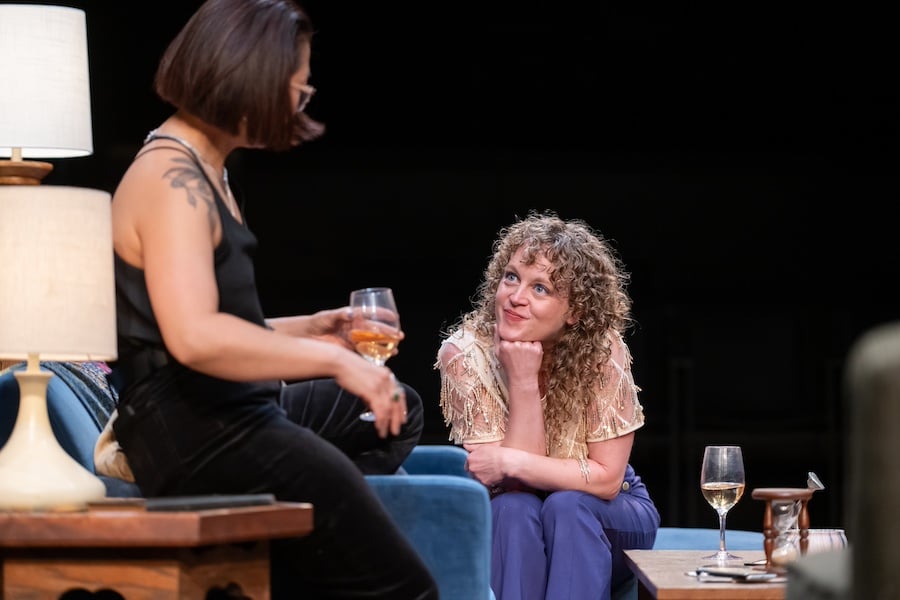There’s a secret at the heart of Paloma Nozicka’s Enough to Let the Light In, a new play running at the Contemporary American Theater Festival through July 28, but it isn’t the one the author intended. Part ghost story, part psychological thriller, part gay romance, Enough to Let the Light In seems to spend its 90 minutes searching for a dramatic center. When the big reveal does come, the production’s slow and sometimes awkward pacing, combined with plot points signaled well in advance, works against the build of tension the story demands. Rather than familiar horror tropes or heady dialogue about belief, doubt, logic, and irrationality, it is the characters’ backstories — particularly that of Cynthia — that elicit our deepest interest and empathy. There’s a lot to uncover in Enough to Let the Light In, but one senses that some of the play’s most rewarding secrets have yet to come to light.
Taking place in artist Cynthia’s (Caroline Neff) spooky and spacious Victorian — nicely designed for middle-class comfort by Mara Ishihara Zinky — Light’s plot unfolds in real time as Cynthia invites new lover Marc (Deanna Myers) over for the first time in the women’s eight-month relationship. Despite Marc’s surprise proposal of marriage (and Cynthia’s sudden acceptance), we know something is wrong when Cynthia’s eerie self-portrait falls off the wall, closet doors are found half-open, and Marc catches Cynthia frantically hiding a bowl of Fruit Loops under the coffee table. (She says she gets the late-night munchies.)

Suspicion grows when, instead of reciprocating Marc’s amorous advances — it is their first night together in Cynthia’s home, after all — Cynthia suggests they play a game of “Two Truths and a Lie” in order to become better acquainted. Haven’t these women just pledged themselves in marriage? It’s unclear whether this is a truly revealing moment or a weak plot device. Nonetheless, the women play the game and learn some of each other’s backstory. We find that psychiatrist Marc is a religious person who, perhaps surprisingly, rejects the idea of fate while embracing logic and reason. Cynthia, a former artist now clerking in an art shop, isn’t religious, but she does believe in fate and, especially, the irrational.
Here, Nozicka sets up a dialectic between the two women and their respective views on reality, but it doesn’t go very far. As Marc says of Cynthia’s perspective, it can all appear “too reductive.” But as the plot becomes spookier, the play’s pacing — somewhat erratic from the start — becomes inexplicably slower. Long pauses don’t hold enough action or intention to build the momentum Nozicka surely desires. Happily, this is something the play’s director (Kimberly Senior) and actors can address. More difficult is Cynthia’s big reveal in the latter half of the play. (Spoiler alert for readers as well as for Marc, the betrothed: Cynthia once had a husband and a young son, and she’s convinced that the son — now dead — is hiding in the walls of her house.)
On the evening I saw the show, there was unintended laughter in response to Cynthia’s declaration about her son’s whereabouts. Probably, the audience needs more and earlier investment in Cynthia’s story, and it may be that some of the tropes Nozicka relies on — a spirit in a closet (or closet wall), a light flash or door opening after characters leave a room — are simply worn. (Then, too, the horror-genre signals are occasionally too obvious or too camp, as when Marc plays a record by the 1960s group The Zombies.)

All that said, I left the theater wanting to know more — not about a real or hallucinatory spook, but about Cynthia’s backstory — about her marriage, about the tremendous struggle she describes between the responsibilities of motherhood and the compulsions of artistic creation, about what it was like to move from heterosexual marriage to singlehood to the idea of marriage again. There is plenty to explore in the characters and the central relationship of Enough to Let the Light In — and Neff and Myers seem to be attempting to do that — but perhaps it is not about the things that go bump in the night.
Running Time: 90 minutes, no intermission
Enough to Let the Light In plays through July 28, 2024, presented by the Contemporary American Theater Festival performing at the Marinoff Theater, 62 West Campus Drive, Shepherdstown, WV, on the campus of Shepherd University, Shepherdstown, WV, in repertory with three other CATF plays. See the CATF website for performance dates and times. Purchase tickets ($40–$70) at catf.org/buy-tickets or through the box office, boxoffice@catf.org or 681-240-2283.
Enough to Let the Light In, by Paloma Nozicka
Directed by Kimberly Senior
Scenic Design: Mara Ishihara Zinky
Costume Design: Peggy McKowen
Lighting Design: Mary Louise Geiger
Sound Design: Christopher Darbassie
DCTA REVIEWS OF THE 2024 CATF:
‘Tornado Tastes Like Aluminum Sting’ at Contemporary American Theater Festival (review by Deryl Davis, July 16, 2024)
‘Enough to Let the Light In’ in rep at Contemporary American Theater Festival (review by Deryl Davis, July 15, 2024)
What Will Happen to All That Beauty?’ at Contemporary American Theater Festival (review by Bob Ashby, July 8, 2024)
The Happiest Man on Earth’ in rep at Contemporary American Theater Festival (review by Bob Ashby, July 7, 2024)



